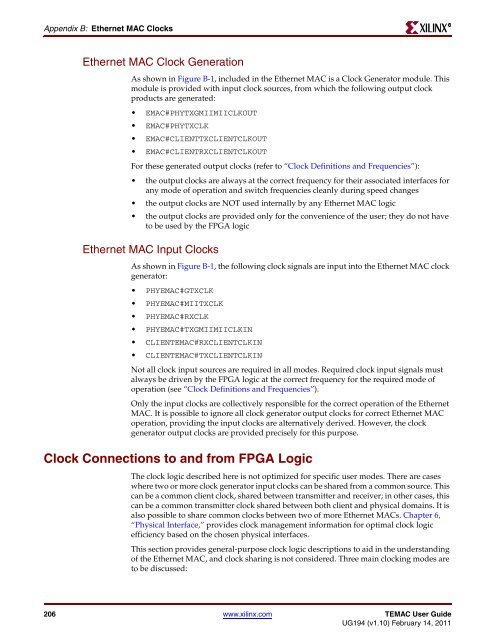Xilinx UG194 Virtex-5 FPGA Embedded Tri-Mode Ethernet MAC ...
Xilinx UG194 Virtex-5 FPGA Embedded Tri-Mode Ethernet MAC ...
Xilinx UG194 Virtex-5 FPGA Embedded Tri-Mode Ethernet MAC ...
Create successful ePaper yourself
Turn your PDF publications into a flip-book with our unique Google optimized e-Paper software.
Appendix B: <strong>Ethernet</strong> <strong>MAC</strong> Clocks<br />
<strong>Ethernet</strong> <strong>MAC</strong> Clock Generation<br />
As shown in Figure B-1, included in the <strong>Ethernet</strong> <strong>MAC</strong> is a Clock Generator module. This<br />
module is provided with input clock sources, from which the following output clock<br />
products are generated:<br />
E<strong>MAC</strong>#PHYTXGMIIMIICLKOUT<br />
E<strong>MAC</strong>#PHYTXCLK<br />
E<strong>MAC</strong>#CLIENTTXCLIENTCLKOUT<br />
E<strong>MAC</strong>#CLIENTRXCLIENTCLKOUT<br />
For these generated output clocks (refer to “Clock Definitions and Frequencies”):<br />
the output clocks are always at the correct frequency for their associated interfaces for<br />
any mode of operation and switch frequencies cleanly during speed changes<br />
the output clocks are NOT used internally by any <strong>Ethernet</strong> <strong>MAC</strong> logic<br />
the output clocks are provided only for the convenience of the user; they do not have<br />
to be used by the <strong>FPGA</strong> logic<br />
<strong>Ethernet</strong> <strong>MAC</strong> Input Clocks<br />
As shown in Figure B-1, the following clock signals are input into the <strong>Ethernet</strong> <strong>MAC</strong> clock<br />
generator:<br />
PHYE<strong>MAC</strong>#GTXCLK<br />
PHYE<strong>MAC</strong>#MIITXCLK<br />
PHYE<strong>MAC</strong>#RXCLK<br />
PHYE<strong>MAC</strong>#TXGMIIMIICLKIN<br />
CLIENTE<strong>MAC</strong>#RXCLIENTCLKIN<br />
CLIENTE<strong>MAC</strong>#TXCLIENTCLKIN<br />
Not all clock input sources are required in all modes. Required clock input signals must<br />
always be driven by the <strong>FPGA</strong> logic at the correct frequency for the required mode of<br />
operation (see “Clock Definitions and Frequencies”).<br />
Only the input clocks are collectively responsible for the correct operation of the <strong>Ethernet</strong><br />
<strong>MAC</strong>. It is possible to ignore all clock generator output clocks for correct <strong>Ethernet</strong> <strong>MAC</strong><br />
operation, providing the input clocks are alternatively derived. However, the clock<br />
generator output clocks are provided precisely for this purpose.<br />
Clock Connections to and from <strong>FPGA</strong> Logic<br />
The clock logic described here is not optimized for specific user modes. There are cases<br />
where two or more clock generator input clocks can be shared from a common source. This<br />
can be a common client clock, shared between transmitter and receiver; in other cases, this<br />
can be a common transmitter clock shared between both client and physical domains. It is<br />
also possible to share common clocks between two of more <strong>Ethernet</strong> <strong>MAC</strong>s. Chapter 6,<br />
“Physical Interface,” provides clock management information for optimal clock logic<br />
efficiency based on the chosen physical interfaces.<br />
This section provides general-purpose clock logic descriptions to aid in the understanding<br />
of the <strong>Ethernet</strong> <strong>MAC</strong>, and clock sharing is not considered. Three main clocking modes are<br />
to be discussed:<br />
206 www.xilinx.com TE<strong>MAC</strong> User Guide<br />
<strong>UG194</strong> (v1.10) February 14, 2011<br />
R

















